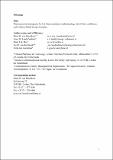Files in this item
Pharmaceutical pictograms for low-literate patients : understanding, risk of false confidence, and evidence-based design strategies
Item metadata
| dc.contributor.author | van Beusekom, Mara M. | |
| dc.contributor.author | Land-Zandstra, Anne M. | |
| dc.contributor.author | Bos, Mark J.W. | |
| dc.contributor.author | van den Broek, Jos M. | |
| dc.contributor.author | Guchelaar, Henk-Jan | |
| dc.date.accessioned | 2019-07-12T09:30:02Z | |
| dc.date.available | 2019-07-12T09:30:02Z | |
| dc.date.issued | 2017-05 | |
| dc.identifier | 259562574 | |
| dc.identifier | 76dba35a-09ef-4943-b94e-f92a27f078c1 | |
| dc.identifier | 28043712 | |
| dc.identifier | 85009494308 | |
| dc.identifier.citation | van Beusekom , M M , Land-Zandstra , A M , Bos , M J W , van den Broek , J M & Guchelaar , H-J 2017 , ' Pharmaceutical pictograms for low-literate patients : understanding, risk of false confidence, and evidence-based design strategies ' , Patient Education and Counseling , vol. 100 , no. 5 , pp. 966-973 . https://doi.org/10.1016/j.pec.2016.12.015 | en |
| dc.identifier.issn | 0738-3991 | |
| dc.identifier.other | ORCID: /0000-0002-4536-0558/work/59464970 | |
| dc.identifier.uri | https://hdl.handle.net/10023/18090 | |
| dc.description.abstract | Objective: This study aims to (1) evaluate ten pharmaceutical pictograms for low-literate patients on understandability, (2) assess the risk of false confidence in understanding, and (3) identify how the design can be improved to increase understandability. Methods: Interviews were conducted with n=197 pharmacy visitors in the Netherlands. Additional qualitative discussions were held with n=30 adequately and n=25 low-literate participants (assessed with REALM-D). Qualitative data were analysed using the Thematic Framework approach. Results: Half of the pictograms reached 67% understanding (31.0%-98.5%); two did in the low-literate group. Three pictograms showed a risk for false confidence. Pictograms appeared to be most effective when people were familiar with their visual elements and messages. Conclusion: Low-literate people have more difficulty understanding pictograms than people with adequate literacy. While the risk of false confidence is low, for critical safety information, 67% understanding might not be sufficient. Design strategies for pharmaceutical pictograms should focus on familiarity, simplicity, and showing the intake and effect of medicine. Practice implications: Health professionals should go over the meaning of pictograms when providing drug information to patients to increase patients' familiarity with the message and to ensure that all pictograms are sufficiently understood. | |
| dc.format.extent | 8 | |
| dc.format.extent | 568200 | |
| dc.language.iso | eng | |
| dc.relation.ispartof | Patient Education and Counseling | en |
| dc.subject | Adult | en |
| dc.subject | Audiovisual aids | en |
| dc.subject | Comprehension | en |
| dc.subject | Drug labeling/methods | en |
| dc.subject | Female | en |
| dc.subject | RA0421 Public health. Hygiene. Preventive Medicine | en |
| dc.subject | RM Therapeutics. Pharmacology | en |
| dc.subject | NDAS | en |
| dc.subject | SDG 3 - Good Health and Well-being | en |
| dc.subject.lcc | RA0421 | en |
| dc.subject.lcc | RM | en |
| dc.title | Pharmaceutical pictograms for low-literate patients : understanding, risk of false confidence, and evidence-based design strategies | en |
| dc.type | Journal article | en |
| dc.contributor.institution | University of St Andrews. School of Medicine | en |
| dc.identifier.doi | 10.1016/j.pec.2016.12.015 | |
| dc.description.status | Peer reviewed | en |
This item appears in the following Collection(s)
Items in the St Andrews Research Repository are protected by copyright, with all rights reserved, unless otherwise indicated.

